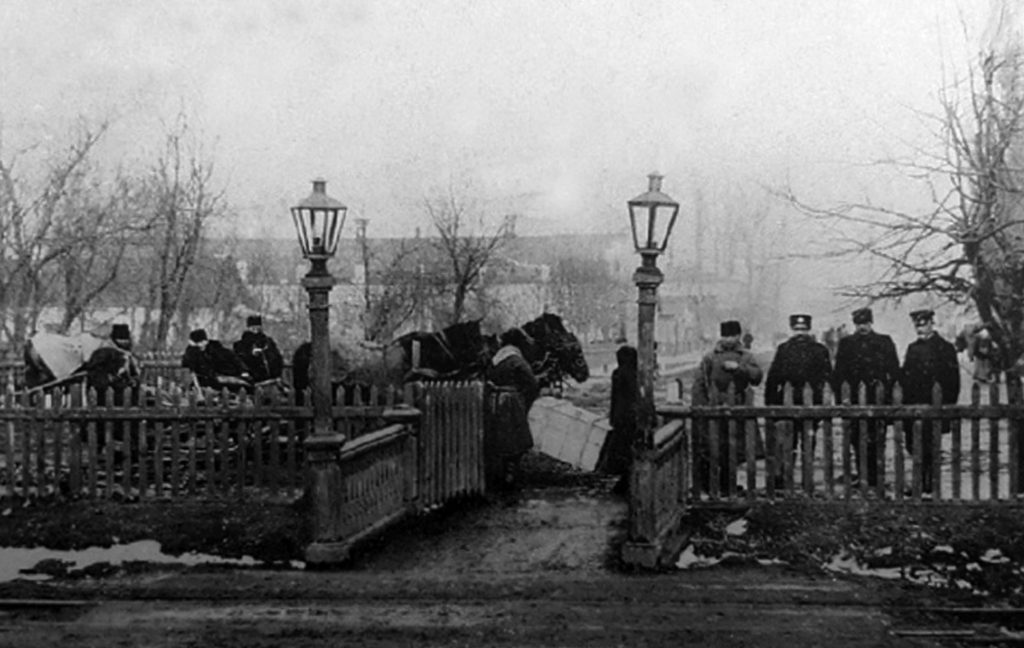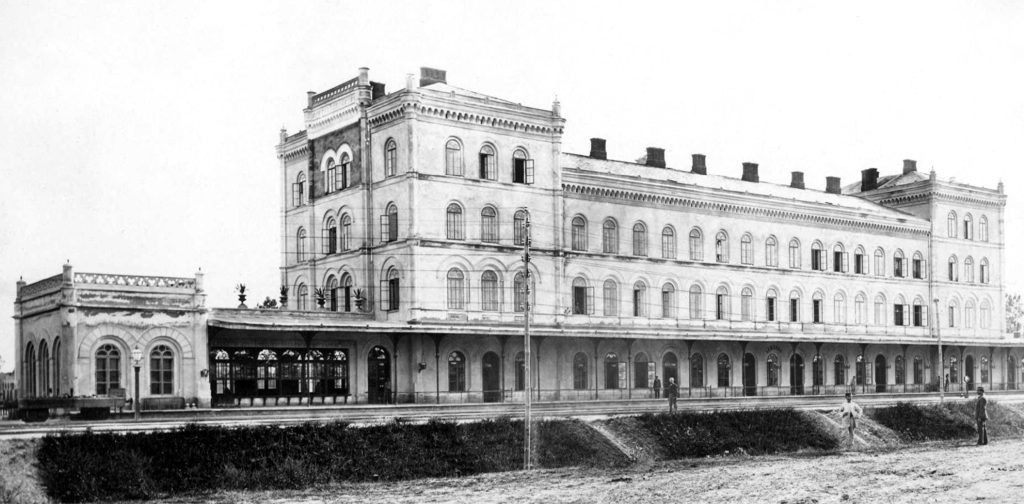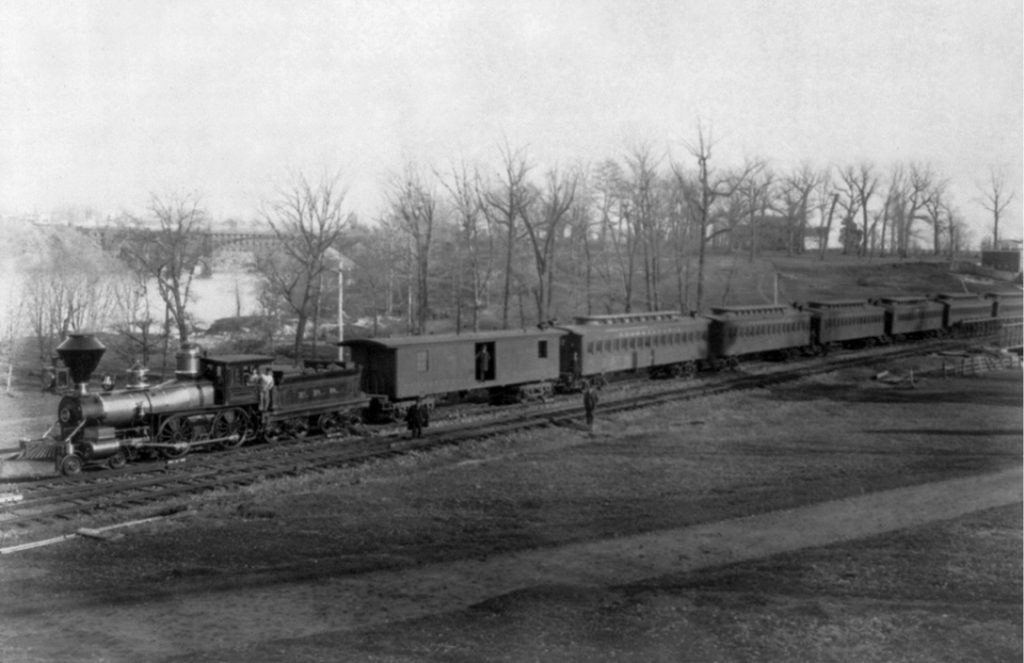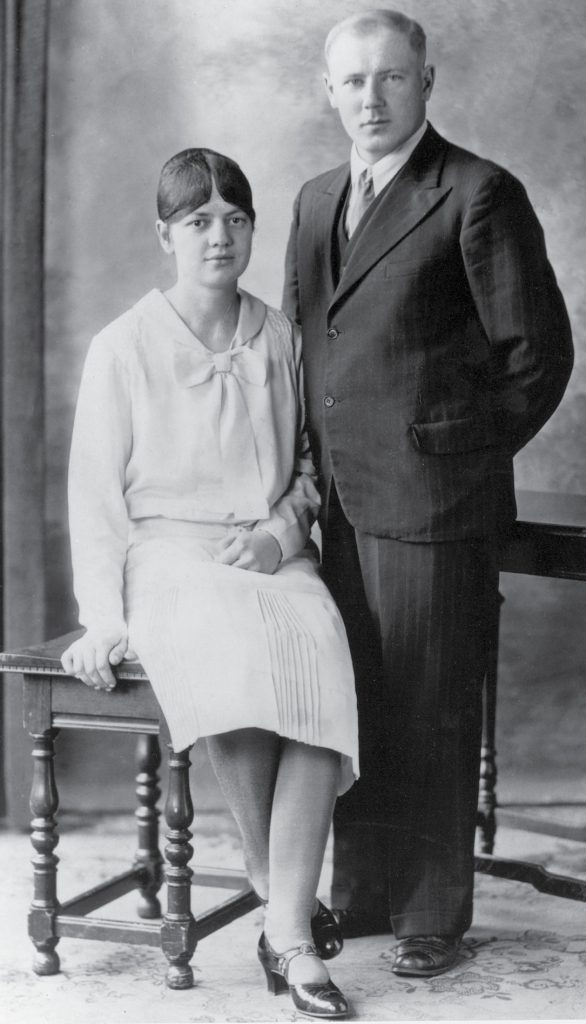Interconnections: An Immigration Story
Ralph Friesen
Imperial Russia to America
The other day I pulled a file called “Rempel Family” from my cabinet, where it had hung suspended and ignored for years. “What’s in here?” I wondered. I found several photocopied documents written in the old German Schrift. These things are tantalizing to me – I can’t just read them as they are, as I might if they were in English or even in German with conventional handwriting. I never know if they contain gems of information, or just mundane stuff, until I sit down and painstakingly transcribe and translate them. I saw that one was entitled “a description of my parents’ journey from Russia to America, 1876.” It looked promising. My maternal grandfather, Peter F. Rempel (1875–1967) of Meade, Kansas, had immigrated to the United States that year, so I concluded that he had made a written copy of the original, written by his father Gerhard Rempel (1843–1879).

I began to transcribe. I was surprised to find the village of Hochstädt (present-day Oleksandropil) as the starting point for the epic journey described by my great-grandfather. As I’d never heard of it, I looked it up in William Schroeder and Helmut Huebert’s Mennonite Historical Atlas. I found out that Hochstädt was located in the Borosenko colony, roughly twenty miles north of Nikopol, a trade centre on the Dnieper River in present-day southern Ukraine. That made sense. My Kleine Gemeinde ancestors had moved to Borosenko from the larger Molotschna colony in the 1860s. But some Old Colony (Chortitza) people had also moved there: Hochstädt was an Old Colony village. As Gerhard and his wife Katharina (nee Friesen,1846–1903) had originally settled in Rosenfeld (he is listed in the ministerial election there in 1869), I would have expected that village to be their departure point. Instead it was Hochstädt, about four miles to the northeast. Most of the Kleine Gemeinde had already emigrated in 1874–5, meaning that the Rempels had lagged behind.
They left with a larger group of Mennonites on June 23, 1876, at eleven in the morning.1 Gerhard says nothing about their children, but genealogical records show there were six: Gerhard, age 11, Katharina, 10, Abraham, 7 going on 8, Elisabeth, just turned 6, Margaretha, 3, and Peter, my grandfather, 1.
They must have started out by horse and wagon. Gerhard methodically lists every stop along the way. They arrived at a station (I cannot make out the name; it looks like “Litowog”) at nine in the evening on that first day, and after a two-hour stop, boarded a train and travelled all night to Kharkov (Kharkiv), a major town in the northeast with a population of over 50,000. It was likely the first time any of them had been on a train, or seen a town of that size. They waited in Kharkov for nearly a day before boarding an evening train that chugged west to Kremenchuk and Yelisavetgrad (now Kropyvnytskyi in central Ukraine).
Early on June 27 they arrived at Volochisk (Volochys’k) near imperial Russia’s western border with the Austro-Hungarian empire, where their passports were examined. After another all-day journey, they crossed the border, arriving in Pidvolochysk (Podwołoczyska, Podvolitchisk), in present-day Ukraine, where they transferred to “Austrian train cars” and pushed on to Lemberg (Lvov, Lviv). Today Lviv is one of the larger cities in western Ukraine, but at that time it was part of Austro-Hungarian Galicia. They progressed to Kattowitz in Germany (present-day Katowice, Poland), and on June 29 at four in the morning they reached Kassel. The next day, late in the afternoon, they arrived in Antwerp, Belgium. “Here we were taken to lodging,” writes Gerhard, without supplying any details. If they had read the Martyrs Mirror they might have reflected on the stories of the Mennonites executed centuries ago for their faith in that city.

On July 1 they went to the harbour to board the SS Vaderland, where they were given a medical examination, which they passed. The Vaderland, part of the Red Star Line, was a 320-foot three-master with a steam funnel and a speed of thirteen knots, only a couple of years old in 1876. It made regular voyages between Antwerp and Philadelphia.
The Vaderland proceeded down the Elbe with its Mennonite cargo. The following day, the ship sailed into the North Sea, and the Rempel family went for three days “without seeing land.” Gerhard inserts one of the few details other than times and destinations: “On Monday evening old Hiebert, father of our leader Nikolai Hiebert of Lichtfelde, died and was buried at sea the same day at six in the evening.”2
Nikolai (Klaas) Hiebert (1834–1920), the immigration group leader, would eventually settle in Minnesota, where he became a cabinet maker and a member of the Krimmer Mennonite Brethren. Lichtfelde (present-day Hrushivka) was a Grosze Gemeinde village in the Molotschna colony, so he was not a Chortitzer. Had a small number of Kleine Gemeinde and an unknown number of Chortitzer joined a Grosze Gemeinde group under Hiebert’s leadership? A quick check of a few names on the extensive Vaderland ship list shows that the families originated from Fischau, Margenau, Fuerstenau – all Molotschna villages.
The Vaderland arrived in Philadelphia at four in the afternoon on July 15 after a thirteen-day voyage, “travelling day and night,” according to Gerhard.3 The travellers stayed overnight in Philadelphia and the next day boarded a train for Pittsburgh, where they arrived on July 17, once more at four in the afternoon. As Gerhard wrote: “Here we transferred trains and arrived in Chicago at 10 a.m. Horses and wagons took us to our lodging. On Monday, July 19, at 10:30 we left Chicago and at 4:30 we crossed the Mississippi River. Tuesday the 20th at 11 a.m. we arrived in Omaha and on Wednesday at 9 a.m. we left Omaha and arrived at DeWitt4 at 4 in the afternoon, where friends came to get us.”
This is how the document ends. Presumably the people who received the Rempels in Nebraska at DeWitt brought them to the Kleine Gemeinde settlement in Jansen, twenty-six miles south. Approximately thirty families had settled in Jansen, arriving on the Hamburg-America Line vessel Hammonia in 1874. The Rempels settled in the village of Heuboden, about half a mile south of the church and a little northwest of Jansen.5 Katharina’s father and stepmother, who had been part of the 1874 group travelling via New York, were in all likelihood among the “friends” who came to collect their children from DeWitt. One day by horse and wagon, seven days of train travel in imperial Russia, the Austro-Hungarian empire, and Germany, a two-week ocean voyage, and six more days by rail in the United States with a one- or two-day trek by wagon at the end, and the Rempels had finally arrived at their destination.

On the Voyage
At first, the Rempel family’s information on the Vaderland passenger list, printed in the volume Brothers in Deed to Brothers in Need, confused me. There was a 32-year-old “Gerad” and a 31-year-old “Catharine” – my great-grandparents. There were six names of their children corresponding with those appearing in GRanDMA Online. No surprise there. But then there was another “Gerad,” (Gerhard), aged 59, another Catharine, aged 37, a 23-year-old Elizabeth identified as a “servant,” and another “Peter,” aged one-half year, who was not my grandfather.6
Who were these other people? A cross-check with GRanDMA made it clear: these additional Rempels were my great-great-grandfather, Gerhard (1817–1888), with his family. The younger Gerhard makes no mention of them in his travel account, and their sudden appearance at the end of the journey introduces a new twist in the plot.
The families must have met up somewhere along the way. The elder Rempels had not moved to Borosenko with their children in the 1860s, but stayed behind in Mariawohl, Molotschna, and must have begun their journey from there. Did they first travel all the way from Molotschna to Borosenko, a distance of about seventy miles, so they could then accompany their children? Or did they meet in Antwerp, having come a different route, and then all leave for Philadelphia together? A somewhat random check of names of heads of families on the ship list (there are 104) and their church affiliations show that most came from Molotschna villages, and a few from the Bergthal colony. The Rempels appear to be the only Kleine Gemeinde family.
There are some errors in the list. The senior Gerhard Rempel’s wife is called “Catherine,” whereas in fact she was Elisabeth, age 35. The supposed 23-year-old “servant” Elizabeth was actually Maria, Gerhard Sr.’s 25-year-old daughter from his third marriage.
Five Wives
And here is where the story takes another unexpected turn. Looking more closely at GRanDMA, I found that Elisabeth (nee Friesen, 1840–1922) was Gerhard Sr.’s fifth wife. (The second, Sara Adrian [1816–1849] was Gerhard Jr.’s mother and my great-great-grandmother.) Each of the previous four women had died prior to Elisabeth and Gerhard Sr.’s marriage in 1862, when she was 21 and he was 45 and the father of five.
What then? About a year later Gerhard Jr. married Elisabeth’s younger sister Katharina (1846–1903) when she was just 17. The younger Gerhard was 20 years old on the day of his wedding. Mind-bogglingly, this means that my great-grandmother and my step-great-great-grandmother were sisters. When Katharina married, Elisabeth became her “mother.”
Would that even have been allowed? In those days, the Gemeinde often had a say as to who married whom, and what match was appropriate. They would oppose the marriage between a widower and the sister of a deceased spouse. I imagine they would have had some questions for both Gerhards, or for Katharina and Elisabeth’s parents.
The younger Gerhard’s account tells us nothing about the actual experiences of the travellers – what it was like for them to journey by train and ship for the first time in their lives, to see large population centres with great and beautiful buildings, to spend endless hours in confined spaces with little children. What did they eat? What kind of washing and toilet facilities did they have? Who else went with them, and what stories did they tell? What fears or excitement did they feel? How were they treated by train conductors and ship stewards? All this has to be filled in with our imaginations.
And what about that second “Peter” on the passenger list, the one who was half a year old? It appears he was the child of the elder Gerhard. As such he would have been a grand-uncle to my slightly older grandfather. But a note on GRanDMA suggests that he may not even have been a Rempel, since Gerhard Sr. already had a son (1848–1908) by that name, who remained in New Russia (present-day Ukraine). But that suggestion only deepens the mystery: why would the elder Rempels be travelling with a young infant not their own? Elisabeth actually would have been capable of having a child. In any case this little boy did not survive into adulthood.
Maria, the young single woman who was not a servant but a daughter of the elder Gerhard, got married two years after arriving in the United States, to Klaas P. Friesen (1854–1926). Just to tangle the web a bit more, Klaas was a first cousin to Abraham Friesen, father of the sisters who had married the Rempels, father and son.
Grandfather Peter F. Rempel used to say he hadn’t forgotten anything about Russia. An attempt at humour, of course, as he was too young to remember anything. He also said he learned to walk on that journey but didn’t specify if it was on a train car or the ship. Only a few years after the Rempel family settled in Nebraska, disaster befell them when my great grandfather Gerhard, the writer of the travel account, was killed in an accident. He was standing on top of a hay wagon that was backed up to the barn. When the barn door was opened, a rooster flew out, startling the horses. Their sudden movement threw Gerhard to the ground where he struck his head. He died on November 29, 1879, at the age of 36.
By that time two more children had been born. Katharina, a widow at age 33, could not run a farm and raise all these children on her own, but she did not re-marry, as often happened in such circumstances. Instead, some of the children were given to other families. Peter, my 4-year-old grandfather, was passed from household to household in the community, like an orphan. His longest stay was with his eldest brother Gerhard (another Gerhard!), but this family was also poor, and Peter grew up that way, working hard, deprived even of shoes that fit properly.7
From our modern perspective we marvel (or are appalled) at the marriage pattern of Gerhard Sr. In my peregrinations in search of information, I found a website called the “Sperling Harms Penner Jost Family Genealogy and History site,” and was surprised to discover a Rempel connection. The site has a page called “the Abraham Penner story and connection with Gerhard Rempel.”8 I found scanned pages from a notebook with entries from several individuals, including the oft-married elder Gerhard Rempel.
Gerhard’s laconic entries simply document the dates of his various marriages, his wives’ deaths, and the births and deaths of children. He first married in 1839 when he was 25, to the widow Helena Wiens Wall. She had a daughter by her first marriage, but this child did not survive. Helena herself died a year or two later and in 1841 Gerhard married another widow, Sarah Adrian Penner, who had had four children in her first marriage, of whom the first three died in infancy. She was pregnant when her husband died and this little boy was two months old when Sarah married Gerhard.
Sarah had five children with Gerhard (three survived) and died on May 28, 1849, when her youngest was eight months old. Six weeks later, Gerhard married Maria Warkentin and fathered three children with her (one died in infancy). Only a month after Maria’s death, Gerhard married Gertruda Barkman, who gave birth to four children, none of whom survived. At last, as mentioned, Gerhard married Elisabeth Friesen two months after Gertruda’s death in 1862. The two children from this marriage, presumably including the mysterious Peter, did not survive.
What can we take from these basic facts? We have this pattern of serial marriages in my great-great-grandfather’s story, of a very high rate of infant mortality, and a high mortality rate of the women, some of whom, we presume, died in childbirth. The time intervals between marriages are brutally short by today’s standards. To some extent they were normal for that time and in that culture. Any widower with young children and no one to help raise them would be in serious financial trouble, quite quickly. And, though it seems crass to say so, a new wife (almost always younger than the previous one) also offered the opportunity of having a new sexual partner. Gerhard Sr. was more than twice as old as his last wife when they married. The entire system, of course, was deeply patriarchal. We find the web of family relationships involving step-children and step-parents and half-siblings impossibly complex, but our ancestors seemed to have figured these things out.
Attached to His Pipe
Gerhard Sr. outlived his son by eight years. We get a glimpse into his character from Klaas Reimer’s 1885 letter written when Gerhard was 68, living with Elisabeth in Jansen: “I should also inform you that Abraham S. Friesens were in Nebraska; they were at [the] Gerhard Rempels’ place and found them all to be in good health. However, our aged uncle cannot forget his wife and whenever they speak of her his tears start flowing. Seemingly he is also preparing to enter the eternal life and is concerned about his former life and whether it will prevent him for entering heaven. One notices immediately that he has meant business. He used to be so attached to his pipe of tobacco that he could hardly abstain. This he has not used for a number of years according to what I have heard. One can well imagine the effort it takes to quit such a habit. Otherwise things are not doing so badly, and they always have sufficient to eat and drink. Uncle Gerhard Rempel was still up and around, but his strength is failing and he has aged very much. He sent his greeting along to everyone.”9
The Kleine Gemeinde strongly opposed tobacco use, so Gerhard must have been on the receiving end of severe admonitions for this perceived sin. But who was the wife he could not forget? Besides Elisabeth, there were four. Sarah Adrian Penner is the most likely one, as that marriage lasted the longest, and resulted in the most living children. What would Elisabeth have made of her husband’s continued mourning for a woman who had died thirty-five years earlier?
Another Connection

I want to connect the dots of one last family link. The above-mentioned Abraham S. Friesens were my great-grandparents on my father’s side. Their son Klaas, my grandfather, married into the Abraham L. Dueck family from Kleefeld, Manitoba. Mrs. Dueck was Elisabeth Rempel, a first cousin to Gerhard Jr. Through this connection my parents, Peter D. Friesen and Margaret Rempel, were third cousins. They were also third, fourth, and fifth cousins via twelve other family relationships, but we don’t want to make ourselves dizzy by following all those trails.
My siblings and I have gone further afield in searching for our spouses, including non-Mennonites. I am sure that is true for my numerous Rempel and Friesen cousins as well. The closely knit family and cultural and religious patterns which prevailed only a few generations ago are gone forever. Common understanding and a shared worldview are also things of the past. Our grandchildren have no knowledge of that world, and theirs is entirely different. But that is the world from which we came.
- Gerhard uses the Old Style (Julian) calendar throughout and I have stayed with that in this article. For the equivalent in North America where the New Style (Gregorian) calendar was used, add thirteen days to each date mentioned. ↩︎
- The elder Klaas Hiebert was born in 1801 in Horsterbusch, Prussia. ↩︎
- The Gregorian calendar date used by the immigration authorities and recorded on the ship list is July 28, 1876. ↩︎
- DeWitt was established in 1872 when the railroad was extended to that point. ↩︎
- Delbert F. Plett, Dynasties of the Mennonite Kleine Gemeinde in Imperial Russia and North America (Steinbach: Crossway Publications, 2000), 401. ↩︎
- Clarence Hiebert, ed., Brothers in Deed to Brothers in Need: A Scrapbook about Mennonite Immigrants from Russia, 1870–1885 (Newton, KS: Faith and Life Press, 1974), 295. ↩︎
- His story is told in A History of the Peter F. Rempel Family (Beaverton, OR: printed by A. Dale Aufrecht, 1995). ↩︎
- http://freepages.rootsweb.com/~sperling/genealogy/penner/claasen.html, accessed May 12, 2021. ↩︎
- Klaas R. Reimer, letter to Bernhard Rempel, Oct. 20, 1885, quoted in Plett, Dynasties, 400–1. Reimer was a nephew to Gerhard Rempel. ↩︎
